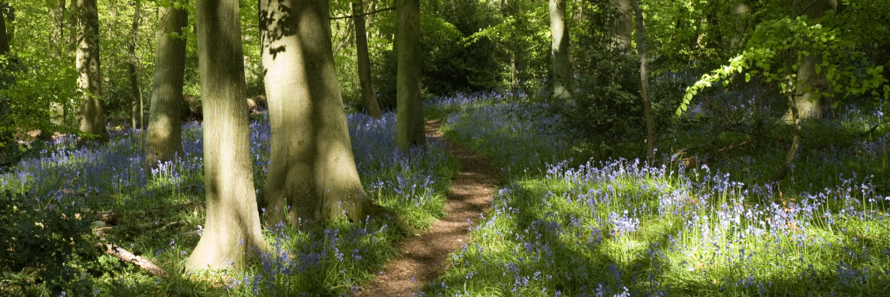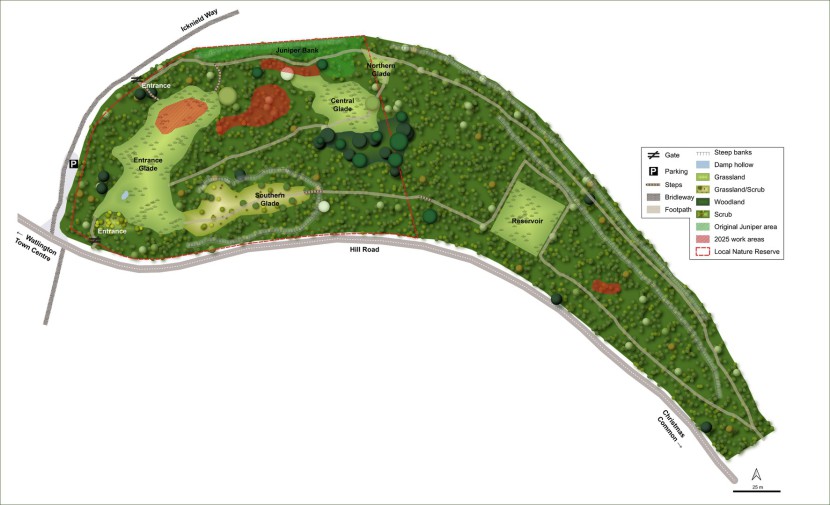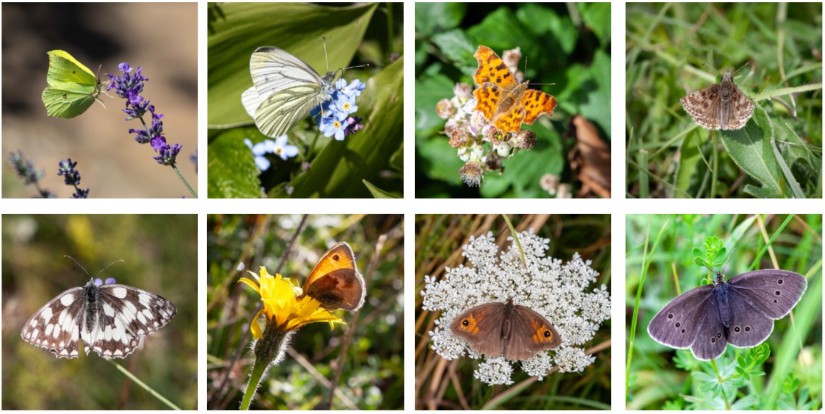Watlington Chalk Pits Local Nature Reserve
WEG manage the Watlington Chalk Pits Local Nature Reserve (LNR), site of a former chalk pit and subsequent landfill site, in partnership with the Parish Council. The LNR is only 1.62ha, but much of it is also designated as a Site of Special Scientific Interest (SSSI), part of the Watlington and Pyrton Hills SSSI which covers an area of over 110ha. The SSSI was designated in 1955, because of its mosaic of habitats: chalk downland, chalk scrub, mixed broadleaved and yew woodland habitats, with areas of leached and more acid grassland and scrub on the upper slopes including some of the most floristically diverse grassland in the Chilterns. The SSSI is also notable for its lower plant flora (lichens, mosses and liverworts) and butterfly populations. The LNR’s particular contribution towards this mosaic is its flower-rich chalk grassland with varied scrub, supporting over 20 species of butterflies, and some rare lichens, mosses and liverworts.
WatlingtonChalkPit_Poster_large.pdf
Adobe Acrobat document [4.4 MB]
Management:
Management is about maintaining a mosaic - if left unmanaged the landscape would revert to scrub then woodland. We are striving to achieve good quality scrub and good quality open areas, rather than compromise between the two. Good quality scrub means dense scrub that provides nesting opportunities for birds. Good quality open areas means a variety of vegetation (depending on the conditions) but not bare soil.
In some parts of the site (yet to be worked on), lanky hawthorn and other bushes reaching the end of their life can be found, which produce only a few berries and shade the whole area so that the ground is essentially bare. In other parts of the site, by removing some of the bushes, pollarding (reducing the height) others so that they re-shoot, and laying the rest (cutting partly through the stem to the point that the stem can be laid flat, but remains alive, and starts putting out new vertical shoots), small areas of dense greenery have been created, providing refuges for invertebrates, and, in time, nest sites for birds. It is important to build a barrier around the perimeter of these areas from off-cuts to protect them from deer browsing, The open areas created between these areas of dense greenery have more light, receive more rain, and have begun to green up with a range of vegetation including marjoram.
The Entrance Glade does not form part of the SSSI, but is an interesting part of the site since the thin soil and exposed conditions form an early-stage chalk grassland habitat, alongside a number of rare bare earth or short turf specialist mosses and lichens. The main challenge here has been encroachment by brambles, both the native bramble and a large aggressively invasive alien form known as ‘Himalayan Giant’. But concerted efforts to dig it out, by WEG volunteers and a party from English Nature volunteers, have started to make an impact. Areas of buddleias exist across the LNR, including on the verges of the entrance glade. These are a non-native species which seeds and spreads vigorously, and nothing grows beneath them, so they are being removed progressively.
The Southern Glade is an area where we removed a lot of scrub, mainly clematis and dogwood, and now a carpet of marjoram comes into flower in June, and a carpet of primroses between the Entrance Glade and Southern Glade provides a glorious display in the spring.
The Central Glade is an area that was being strangled by sprawling clematis in the early 2020s, but through a carefully-planned programme of summer and winter mowing in compartments, the clematis has been brought under control, and forms a carpet of purple marjoram in June / July, giving off a lovely herbal smell if the foliage is brushed as you walk through.
The north-facing bank of the holloway along the northern boundary of the site was cleared in 2025. Its north-facing aspect means it is cooler, shadier and damper than archetypical chalk grassland, so also harbours some unusual mosses and is likely to have a different assemblage of flowering plants.
Geology:
Chalk is a white, soft, porous sedimentary rock that is formed from lime mud sediment. Lime mud is composed of minute calcite crystals that are derived from the disintegration of the skeletons of tiny floating marine organisms. These fragments are less than a micron in size. The bulk of the calcareous matter in chalk comes from coccolithophorids. They are a type of phytoplankton that live in deep clear warm seas. They are made up of spherical tests, called coccospheres that are in turn made up of calcareous plates called coccoliths. A coccosphere is 10 -25 microns in diameter. When the coccolithophorids die they fall to the seabed, probably as zooplankton faecal pellets, breaking up into coccoliths and fragments of coccoliths creating a very fine mud.
Lime mud is deposited at a rate of 2.0 cm to 2.5 cm per thousand years. The lime mud is transformed into chalk through geological processes. As more lime mud builds up and the seafloor subsides the sediment is heated and pressurized removing the water from between the particles and becomes compacted. Larger skeletal fragments and occasionally complete skeletal fossils of other larger marine organisms, such as bivalves, echinoids, ammonites, bryozoans and sponges, can be found in chalk outcrops. Specific climatic and environmental conditions are necessary for the organisms that make up the lime mud to live. They require shallow warm seas, with little clastic sedimentary input (i.e. no large rivers discharging sediment derived from rock weathering).
The chalk that outcrops in the Chilterns was deposited during the Upper Cretaceous, when the area now known as Oxfordshire was located at a latitude of ~30° N (current latitude of Morocco) and at water depths between 100 m and 300 m. The Upper Cretaceous was a time of peak temperatures, with high CO2 and the Earth was ~5°C warmer. This also means that sea-levels were at their highest.
Chalk was quarried from the Watlington Chalk Pit and has many uses. As children many of us will have used it to draw and write. It can be used as a building stone (there are many good examples of this in Watlington) and chalk rubble is often used in road construction. When it is heated it becomes lime which is used in the production of products such as steel, aluminium, glass and cement and can also be used as a fertilizer.
Flora & Fauna (focused on prominent species in June / July):
The LNR is home to over 130 flowering plant species, 36 bird species, 18 butterfly species, and 30 liverworts and mosses.
Birds - listen out for Blackcaps, Chiffchaffs, Wrens, Skylarks, Bullfinches, Goldcrests and Blackbirds.
Butterflies - across the whole site, you are likely to come across Brimstone, Green Veined White, Comma, Dingy Skipper (top row below, left to right), Marbled White, Small Heath, Meadow Brown, Ringlet (bottom row below, left to right) during the months of June and July. Common Blue and Brown Argus are also archetypal chalk grassland butterflies and may be seen throughout the summer.
Flora -
Through the Southern Glade:
- Hairy St John's Wort, with yellow flowers and sepals covered in tiny black spots
- Common Ragwort, food plant for Cinnabar moth caterpillars
- Tutsan, likley a garden escapee with curious berries on a small shrub
- Dark Mullein, a tall pillar-like flower-spike with beautiful yellow and purple flowers, used by Mullein moth caterpillars
In the Entrance Glade:
- Common Twayblades, with a characteristic double leaf, can be see in the area adjacent to Hill Road, flowering during June
- Common Centaury with small pink flowers
- Creeping Cinquefoil, which look like buttercups but have five petals and a notch in the outer edge of each
- Pyramidal Orchid
- Common Spotted Orchid
- Bird's-foot Trefoil, used by the chalk-land butterflies Common Blue and Dingy Skipper
- Squinancywort, a dainty white flower
- Wild Thyme
- Philbert's Tamarisk moss, Fir Tamarisk moss, Slender Ditricum moss (too small to see!)
- Black Earthtongue Fungi (appears in November)
- Yellow Wort, small erect plants with unusual pale green-white perfoliate leaves wrapping around the stem
The holloway / Juniper Bank:
- Water Figwort, with its maroon flowers, has appeared on the cleared bank, which is surprising since it usually likes damp conditions such as riverbanks, pond margins, etc.
- Purging Buckthorn, foodplant for the Brimstone butterfly caterpillar
- Dogwood
- Juniper, the last remaining example in the LNR
Northern Glade and Central Glade:
- Hairy St John's Wort and Common Ragwort
- Selfheal, with small blue flowers
- Ploughman's Spikenard, a tall plant with multiple flower stems




